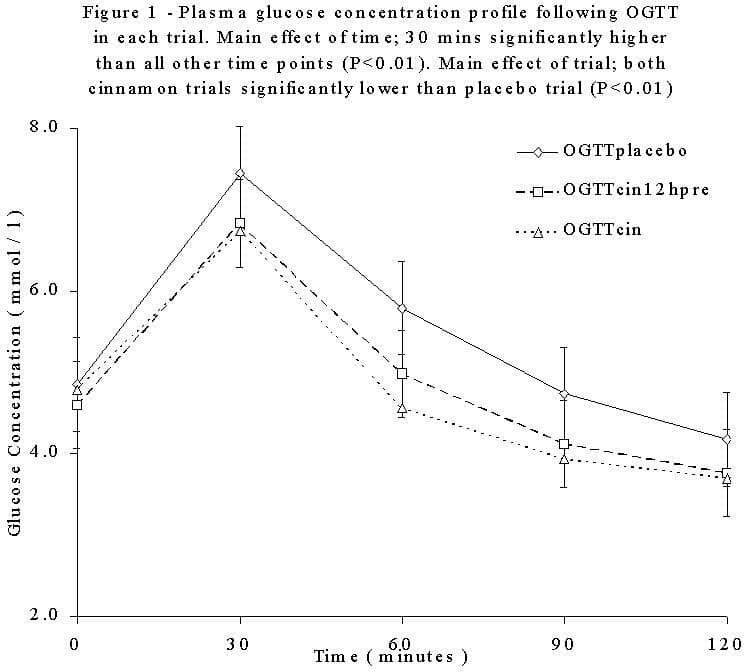Recent epidemiological evidence shows an alarming increase in the prevalence of Type 2 Diabetes (Mokdad et al. 2001). Various natural compounds have been shown to be effective in improving glucose tolerance. For example, it has been shown that cinnamon may improve fasting glucose and triglyceride concentrations in type 2 diabetics (Khan et al. 2003), and in vitro work illustrates its potential as an insulin mimetic (Jarvill-Taylor et al.2001). The aim of the present study was to investigate the time-course of the effect cinnamon may have on glucose tolerance in normoglycaemic humans. Following local ethical approval seven sedentary males aged 26 ± 1 years with a BMI of 24.5 ± 0.3 kg m-2 (mean ± S.E.M.), underwent three oral glucose tolerance tests (OGTTcin12hpre, OGTTcin, OGTTplacebo) in a double-blind crossover design. The OGTT’s followed the standard protocol of 75g D-glucose in 300ml water following an overnight fast. In the OGTTcin12hpre trial subjects consumed 5g of capsulated cinnamon 12 hours prior to the OGTT and 5g of placebo capsules with the OGTT; in the OGTTcin trial the order was reversed so that the cinnamon was consumed with the OGTT; and for the OGTTplacebo subjects consumed 5g of placebo capsules 12 hours before and with the OGTT. Venous blood samples were taken at 0, 30, 60, 90 and 120 mins during the OGTT’s. Plasma glucose and insulin concentrations were measured using colourimetric (ABX Diagnostics, COBAS) and ELISA (DRG International) assays respectively. All subjects kept a 24-hour food diary prior to the first trial, which was replicated prior to each subsequent test. Subjects also abstained from exercise, caffeine, alcohol and any cinnamon products for 24 hours prior to each trial. Data are reported as means ± S.E.M. and were analysed using repeated measures ANOVA (two-way for raw data, one-way for area under curve) and Tukey post-hoc tests were used to compare cinnamon and placebo trials. Both glucose (Fig.1) and insulin responses to the oral glucose bolus ingestion showed significant changes from baseline in all trials at t = 30 minutes (P<0.01). There was also an effect of trial on plasma glucose responses in both cinnamon trials compared to OGTTplacebo (P<0.01, Fig.1). Area under the curve for plasma glucose was significantly decreased (P<0.05) in both the OGTTcin12hpre (604 ± 36 mmol.l-1.2hours) and OGTTcin (584 ± 37) trials compared to OGTTplacebo (675 ± 39). Area under the curve for insulin was not statistically different for the three trials. These findings illustrate that cinnamon can improve glycaemic control for at least 12 hours in humans.
King's College London (2005) J Physiol 565P, C40
Communications: The effect of short-term cinnamon ingestion on in vivo glucose tolerance in humans
Solomon, Thomas J; Blannin, Andrew K;
1. School of Sport and Exercise Sciences, University of Birmingham, Birmingham, United Kingdom.
View other abstracts by:
Where applicable, experiments conform with Society ethical requirements.

